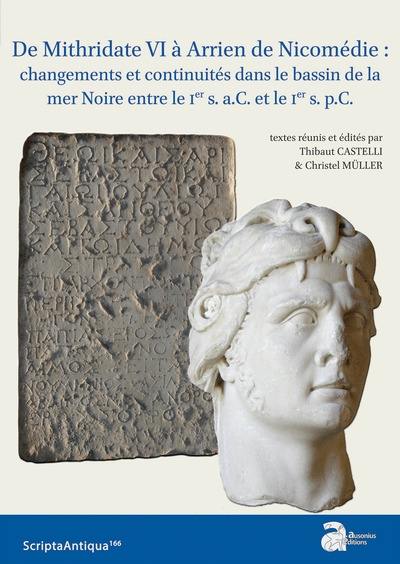
Fiche technique
Format : Broché
Nb de pages : 278 pages
Poids : 540 g
Dimensions : 17cm X 24cm
ISBN : 978-2-35613-526-1
EAN : 9782356135261
De Mithridate VI à Arrien de Nicomédie
changements et continuités dans le bassin de la mer Noire entre le Ier s. a.C. et le Ier s. p.C.
actes du colloque de Paris Nanterre, 2 et 3 mars 2018
Quatrième de couverture
De Mithridate VI à Arrien de Nicomédie
La mer Noire, colonisée par les Grecs depuis le VIIe siècle, a connu une floraison de cités qui ont conservé leur indépendance sauf dans le Royaume du Bosphore. Mithridate VI, le premier, a constitué la quasi-unité de cet espace en contrôlant brièvement l'ensemble du littoral pontique vers 100 a.C. Moins de deux siècles plus tard, l'intégralité ou presque de ce littoral est soumis à Rome, comme le rappelle le Périple du Pont-Euxin d'Arrien. Ces deux siècles (100 a.C.-100 p.C.) sont à la charnière des histoires grecque et romaine, l'une voyant dans cette période la fin de l'époque hellénistique dans sa version régionale, l'autre y cherchant les prémices du contrôle romain sur la mer Noire. L'état actuel de l'historiographie témoigne de cette difficulté à penser ensemble ces deux siècles. Après les publications pionnières, comme celles de François de Callataÿ sur les guerres mithridatiques, ce sont souvent des découpages plus larges qui ont été récemment mis en avant dans des études centrées sur les populations de l'intérieur, comme dans les travaux russes, bulgares ou roumains des années 2010, tandis que la fin du Ier s. a.C. est parfois également étudiée comme prologue à la période impériale. Plusieurs événements marquants manifestent, en effet, une rupture : l'attaque de Burebista vers 48 a.C. dans l'Ouest et le Nord-Ouest, le règne d'Aspourgos dans le Bosphore à partir de 8 a.C., l'annexion des villes grecques du Pont Gauche aux environs de notre ère, la création de la province de Mésie en 15 p.C., la fin du royaume thrace en 46 p.C., l'annexion par les Romains du Pont Polémoniaque en 64 p.C. Mais les continuités existent également dans les différents domaines, politique, économique, social, culturel. Cette question des ruptures et continuités constitue donc le fil rouge du volume, assortie d'une réflexion sur les spécificités pontiques dans la périodisation.
The Black Sea, colonized by the Greeks since the 7th century BC, witnessed the development of cities that maintained their independence except for the Bosporan Kingdom. Mithridates VI was the first to master briefly nearly all of this area through his control of its shores around 100 BC. Less than two centuries later, almost the whole of this coastline was subject to Rome, as Arrian recalls in his Periplus of the Euxine Sea. These two centuries (100 BC-100 AD) lie at the crossroads of Greek and Roman history. The former sees this period as the end of the Hellenistic period in its regional version, the latter as the beginning of Roman control over the Black Sea. The present state of historiography attests to the difficulty of thinking of these two centuries in a joined-up way. After the pioneering publications, such as those of François de Callataÿ on the Mithridatic wars, it is often broader divisions that have recently been put forward in studies centered on the hinterland populations, as in the Russian, Bulgarian or Romanian works of the 2010s, while the end of the 1st century BC is sometimes also studied as a prologue to the imperial period. Several important events reveal a change : Burebista's attack on the West and Northwest around 48 BC, the reign of Aspurgos in the Bosporan Kingdom from 8 BC, the annexation of the Greek cities of the Western coast of the Black Sea at the beginning of the 1st century AD, the creation of the Province of Moesia in AD 15, the end of the Thracian Kingdom in AD 46, and the annexation by the Romans of the Pontus Polemoniacus in AD 64. But continuities also exist in the various political, economic, social and cultural fields. This question of change and continuity is therefore the common thread running through the whole volume, together with a reflection on the Pontic specificities of the periodization.





